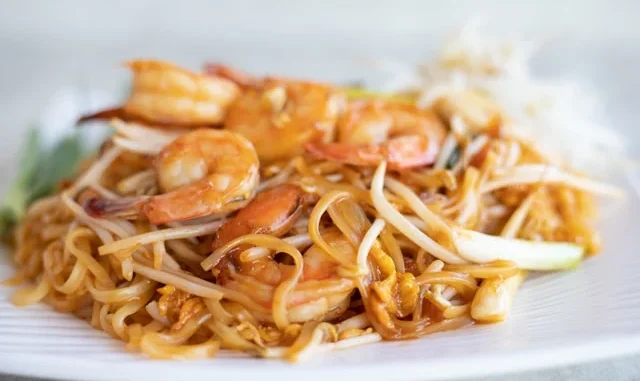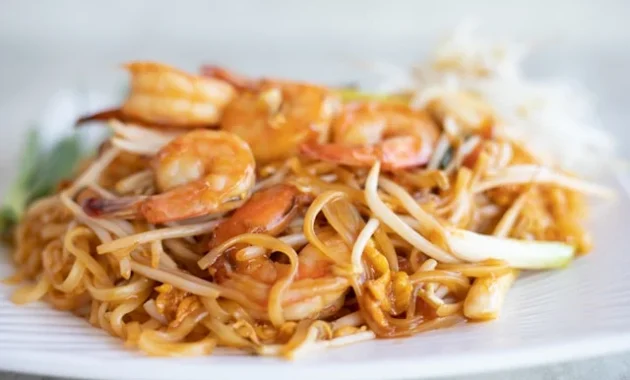
Thailand’s cuisine is a harmonious blend of sweet, salty, sour, and spicy flavors, making it one of the most beloved and sought-after culinary traditions worldwide. From bustling street markets to upscale restaurants, Thai food offers a rich and diverse palette that captures the essence of the country’s cultural heritage. In this comprehensive guide, we explore Thailand’s most iconic dishes, each of which provides a unique taste of the nation’s gastronomic prowess.
Pad Thai: The Quintessential Thai Dish
No discussion of Thai cuisine is complete without mentioning Pad Thai. This ubiquitous street food favorite is a staple in both local eateries and high-end restaurants.
Ingredients and Preparation
Pad Thai is a stir-fried noodle dish that typically includes rice noodles, eggs, tofu, shrimp or chicken, and a medley of vegetables such as bean sprouts and green onions. The dish is tossed in a flavorful sauce made from tamarind paste, fish sauce, palm sugar, and dried shrimp, which gives it a perfect balance of sweet and savory flavors. Garnished with crushed peanuts, lime wedges, and fresh cilantro, Pad Thai is a delicious and aromatic dish that appeals to all palates.
Cultural Significance
Originating in the mid-20th century, Pad Thai was introduced as part of a national campaign to promote Thai nationalism and economic self-sufficiency. Its popularity has since soared, becoming a symbol of Thai cuisine around the world.
Tom Yum: The Spicy and Sour Soup
Another cornerstone of Thai cuisine is Tom Yum, a hot and sour soup that exemplifies the bold flavors characteristic of Thai food.
Ingredients and Preparation
Tom Yum is made with a broth infused with lemongrass, kaffir lime leaves, galangal, and fresh chili peppers. The soup usually features shrimp (Tom Yum Goong) or chicken (Tom Yum Gai) as the primary protein. The addition of fish sauce, lime juice, and roasted chili paste creates a spicy and tangy flavor profile that is both invigorating and satisfying. The soup is often garnished with fresh cilantro, enhancing its aromatic qualities.
Variations and Regional Differences
While Tom Yum Goong is the most well-known version, there are several variations of this iconic soup. Tom Yum Nam Sai is a clear broth version, whereas Tom Yum Nam Khon includes coconut milk or evaporated milk for a creamier texture. Each region of Thailand has its unique take on the dish, reflecting local ingredients and culinary traditions.
Green Curry: A Creamy and Spicy Delight
Green Curry (Gaeng Keow Wan) is a favorite among Thai food enthusiasts, known for its rich, creamy texture and vibrant green color.
Ingredients and Preparation
The signature green curry paste is made from fresh green chilies, lemongrass, kaffir lime leaves, galangal, garlic, and shrimp paste. This paste is sautéed with coconut milk to form the base of the curry, which is then combined with a variety of vegetables and proteins such as chicken, beef, or tofu. The addition of Thai basil leaves and eggplant enhances the flavor and adds depth to the dish.

Serving Suggestions
Green Curry is typically served with jasmine rice or thin rice noodles, which help to balance the spiciness of the curry. The aromatic and creamy sauce makes it a comforting and indulgent meal.
Som Tum: The Refreshing Green Papaya Salad
Som Tum is a refreshing and spicy green papaya salad that is a staple in Thai cuisine, particularly in the northeastern region of Isaan.
Ingredients and Preparation
Som Tum is made with shredded green papaya, tomatoes, green beans, and peanuts, all pounded together in a mortar and pestle with garlic, chili, lime juice, fish sauce, and palm sugar. The result is a dish that is simultaneously spicy, sour, sweet, and savory, with a satisfying crunch from the fresh vegetables and peanuts.
Variations and Accompaniments
There are several variations of Som Tum, including Som Tum Thai (with dried shrimp and peanuts), Som Tum Pla Ra (with fermented fish sauce), and Som Tum Pu Pla Ra (with pickled crab and fermented fish sauce). This versatile salad is often enjoyed with sticky rice and grilled meats, making it a perfect accompaniment to a Thai meal.
Massaman Curry: A Rich and Aromatic Stew
Massaman Curry is a unique Thai dish with influences from Persian and Indian cuisine, characterized by its rich and aromatic flavor profile.
Ingredients and Preparation
The curry paste is made from a blend of spices such as cinnamon, cardamom, cloves, and nutmeg, combined with traditional Thai ingredients like lemongrass, galangal, and shrimp paste. This paste is cooked with coconut milk to create a thick, flavorful sauce. The curry typically includes meat (beef or chicken), potatoes, and peanuts, which absorb the aromatic sauce beautifully.
Cultural Significance
Massaman Curry is often served during special occasions and family gatherings, reflecting its significance in Thai culture. Its complex flavor and rich texture make it a favorite among both locals and tourists.
Khao Soi: The Northern Thai Noodle Soup
Khao Soi is a beloved dish from Northern Thailand, particularly Chiang Mai, known for its rich and creamy coconut curry broth.
Ingredients and Preparation
The dish features egg noodles served in a coconut curry soup, topped with crispy fried noodles for added texture. The curry paste, made from red chilies, turmeric, and other spices, is mixed with coconut milk to create a creamy and flavorful broth. Chicken or beef is commonly used as the protein, and the dish is garnished with pickled mustard greens, shallots, and lime wedges.
Regional Variations
Khao Soi has several regional variations, with each province in Northern Thailand offering its unique take on the dish. Some versions may include additional spices or different types of meat, reflecting the diverse culinary traditions of the region.